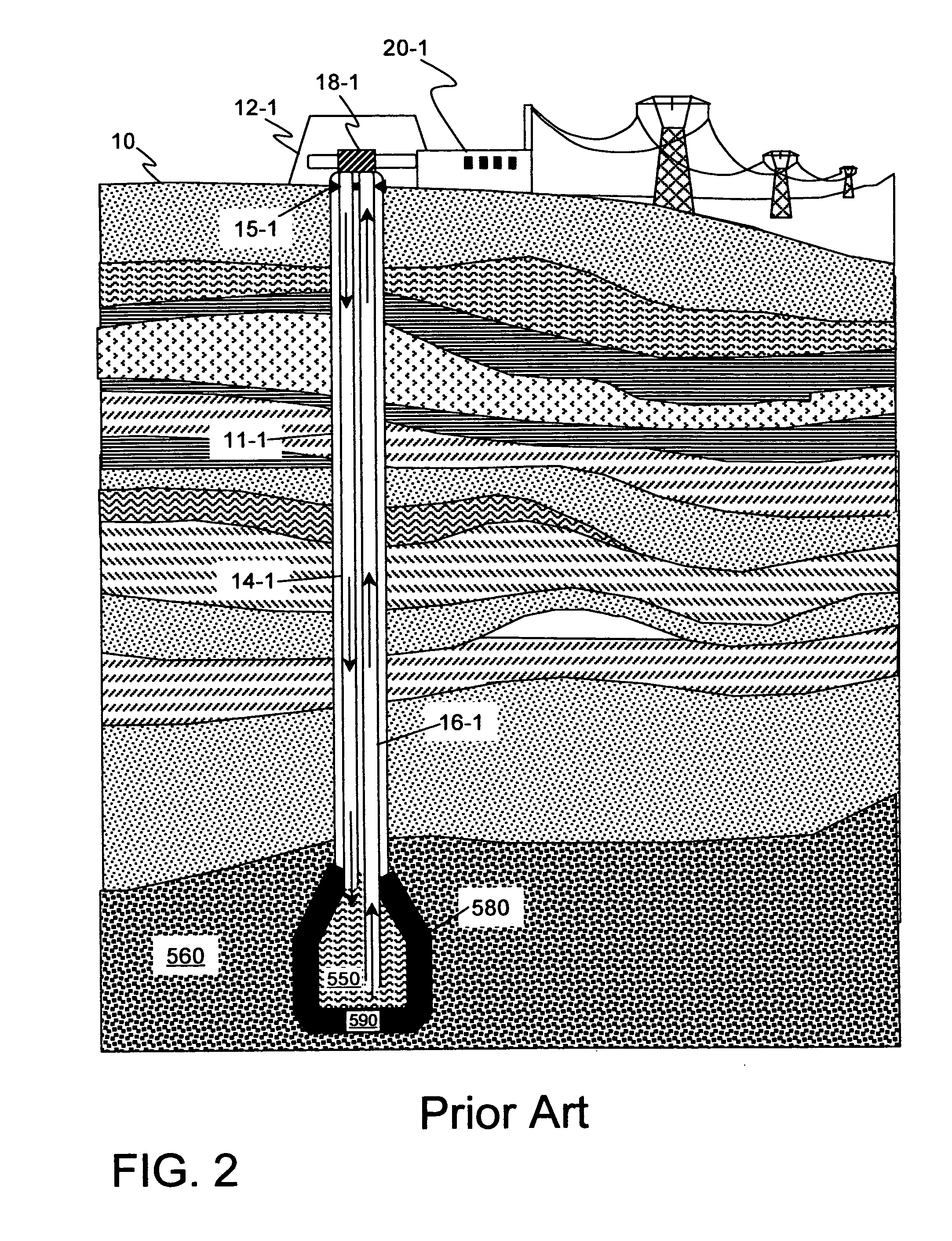Geothermal energy collection system
a technology of geothermal energy and collection system, which is applied in the direction of machines/engines, greenhouse gas reduction, lighting and heating apparatus, etc., can solve the problems of only using techniques, wells of this depth, and high cost of drilling,
- Summary
- Abstract
- Description
- Claims
- Application Information
AI Technical Summary
Benefits of technology
Problems solved by technology
Method used
Image
Examples
first embodiment
the Invention
[0059]One embodiment of the invention is illustrated in more detail in FIG. 5 and FIG. 6. Note that these illustrations are not to scale, since the wells are anticipated to be kilometers deep while the thermal masses are expected to be, for example, 1 to 30 meters long and perhaps 50 to 100 centimeters in diameter.
[0060]In this embodiment of the invention, the deeper part of the well shaft 60 surrounded by the thermal pool 560, can be lined with a thermal casing 64 that facilitates the transfer of heat from the thermal pool 560 to the thermal mass 100. This thermal casing can be made using a material such as a thermally conducting grout, often made from compositions comprising water, cement, siliceous gel, and sometimes bentonite. Additional materials such as iron filings or other metallic powders can be mixed into the grout to enhance thermal conductivity. The surface can also be treated to be smooth to increase emissivity for enhancing radiative heat transfer. Althoug...
second embodiment
the Invention
[0084]FIG. 11, FIG. 12 and FIG. 13 show an alternative embodiment of the invention. In this embodiment, as in the first embodiment, a well shaft 60 can be dug to a thermal pool 560. As before, the well shaft 60 can be lined with various casings, such as an insulating casing 62 in the upper portions of the shaft and a thermal casing 64 in the lower portion of the shaft. As before, a thermal mass 100-2 is lowered on a suspension cable 140 to a Heat Absorption Zone, heated by the thermal pool 560. After heating, the thermal mass 100-2 is then raised to a Heat transfer Zone near the surface of the Earth 10, and the heat unloaded into a thermal reservoir 300 contained in a thermal reservoir containment 380. The thermal mass 100-2 again comprises a cylindrical exterior shell 101, which can be the same design as was illustrated for the previous embodiment in FIG. 8, and can also have an interior cavity containing a thermal fluid 55 covered with a cover gas 56.
[0085]However, in...
third embodiment
the Invention
[0094]In the previously described embodiments, the thermal mass can be lowered into the thermal well and then raised once it has acquired heat. However, for a single thermal mass raised into a single thermal well, significant energy must be expended to raise the thermal mass against the pull of gravity. This may place a practical limit on the mass that can be used, since a thermal mass that is heavier will require more energy to raise, especially when the wells are at depths of kilometers. However, heavier masses may be advantageous from a thermal energy point of view, in that heavier, denser thermal masses can have a significantly larger heat capacity, and therefore acquire more heat to be harvested once the thermal mass is returned to the surface.
[0095]An alternative embodiment of the invention can mitigate the energy expenditure required to raise warmed thermal masses from the thermal well. In this embodiment, at least two (2) paired thermal masses are connected by a...
PUM
 Login to View More
Login to View More Abstract
Description
Claims
Application Information
 Login to View More
Login to View More - R&D
- Intellectual Property
- Life Sciences
- Materials
- Tech Scout
- Unparalleled Data Quality
- Higher Quality Content
- 60% Fewer Hallucinations
Browse by: Latest US Patents, China's latest patents, Technical Efficacy Thesaurus, Application Domain, Technology Topic, Popular Technical Reports.
© 2025 PatSnap. All rights reserved.Legal|Privacy policy|Modern Slavery Act Transparency Statement|Sitemap|About US| Contact US: help@patsnap.com



